Eleven permanent artworks will be installed in Rijeka and its surrounding area, more specifically at ten locations across the Kvarner region as part of this flagship, one of seven overall. The artworks, installations and sculptures uniformly deal with the specificities of the locations where they are being installed.
The guiding principle was to concentrate on the issues that are important to the local population and that link the past to the present to some extent. The curator of the Lungomare Art programme is the renowned European curator, the Czech Michal Koleček, who selected acclaimed European, Croatian and global artists to create the sculpture and installations.
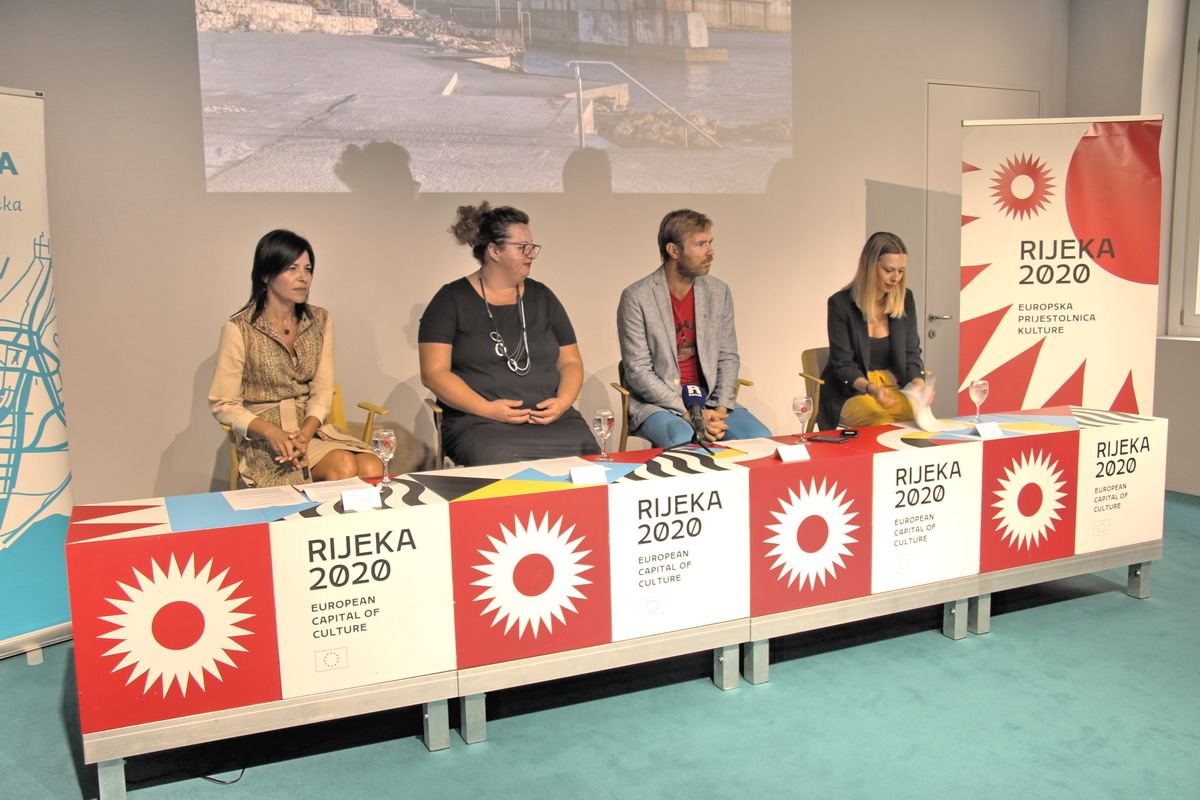
Small towns and villages in Kvarner on the cultural map of Europe
The idea behind the programme concept is to have contemporary art leave the museums and meet local communities by forming a new culture-and-arts route that brings new and permanent value to places participating in the programme. “Lungomare Art” tells stories that you can’t find in your run-of-the-mill tourist brochures and you may start exploring them from any location you wish. On the coast: at the entrance to Brseč, on the hiking trail overlooking Lovranska Draga, on the walkway and under the water in Volosko, at the Rijeka Fish Market, at Grčevo Beach in the Rijeka neighbourhood of Pećine, at Svežanj Beach in Žurkovo in Kostrena or in the park at the centre of Crikvenica. Or on the islands: in the park by the pier in Lopar on Rab, above Baška on Krk or at Vela Riva in Mali Lošinj.
The installations, created by renowned artists, designers and architects from Croatia, Europe, Japan and Chile evoke traditions and stories that are important to local communities. In addition to their aesthetic value, these sculptures will also have a functional one following their transformation into new rest areas, playgrounds and areas for conversation and studying. The numerous partners of the Lungomare Art flagship were attracted to the project by the fact that it will increase the visibility and appeal of their towns and villages and that the artists’ expression will allow them to tell their own interesting local stories, bring them to the attention of the cultural audience and visitors and become an identifiable and noticeable fixture on the cultural map of Europe.
Croatian culture as an integral part of European cultural heritage
The permanent value of this programme maintains a physical presence in the sculptures and installations placed at the aforementioned locations, while offering interesting and hitherto untold stories to potential visitors in the form of artworks. The reputation and recognition of the commissioned artists at the European and global levels will inevitably draw the attention of art lovers to these locations, thus increasing the value of tourist visits to Croatia and Kvarner in the future.
Works by artists from Europe, the rest of the world and Croatia that are displayed in Rijeka and Kvarner as part of the Lungomare Art flagship bear evidence of the uniqueness of European culture, which is rich in diversities that connect and bring together European and global citizens. The stories from Kvarner, as told through artworks, are incorporated into the cultural and artistic heritage of Europe and affirm the historical and contemporary belonging of Croatia to the European cultural area.

SofieThorsen, photo: Tanja Kanazir
From the back pages of school notebooks – into the stone sculpture in Brseč
The small local community of Brseč had to accept the fact that the local primary school would be closed down in 2018 due to a lack of children after being open for 175 years. What was once crucial for developing the identity of the local community and a hub of social life and children’s play had become insignificant.
The project undertaken by the Austrian-based Danish artist Sofie Thorsen links two locations – the currently abandoned primary school building and the small park next to the bocce court at the entrance to the historic centre of Brseč. The artist is making a valuable stone sculpture in the park with abstract text and shapes written on it that refer to local stories as small graffiti replicas of the kinds that are usually carved into the walls by children with keys or other sharp objects or scribbled on the back pages of school notebooks, which the artist found in the school that had recently been closed down. This sculpture can also double as a bench or table, where locals of all ages can socialise and relax. In addition to the educational role of the primary school building, Sofie Thorsen’s artistic expression also pays homage to the notable author Eugen Kumičić, who was born in Brseč in 1850 and frequently visited the town. This will make the bocce court, revitalised park and the new art structure appealing to the local community.

DavorSanvincenti, photo: Tanja Kanazir
Marron and stone pavilion on the hiking trail in Lovranska Draga
Situated high on Mount Učka, the tiny village of Lovranska Draga cultivates the intense relationship between mankind and nature due to its geographical position. The abundance and quality of natural spring water was one of the main reasons for settlement in the village. Today, Lovranska Draga is dominated by lush marron forests. The historical necessity of communicating and trading with the town of Lovran and other settlements on the coast resulted in the formation of a mesh of trails in the area, ranging from wide cobbled trails traversed by beasts of burden and mountain trails used for grazing to small dry-stone bridges that used to be built due to the frequent floods.
The concept devised by the Croatian artist Davor Sanvincenti is based on the idea of creating a space that will blend in with the current environment of Lovranska Draga and become a meeting and resting place, as well as a place for learning more about the unique features of the area. The artist will build a pavilion on the hiking trail in Lovranska Draga (near the remnants of the old mill), which stretches from the seashore to the summit of Mount Učka. It will be constructed from natural materials, such as chestnut wood and stone, with the aim of providing a place for relaxation and refreshment, or in other words, a natural shelter where passers-by can encounter the locals.
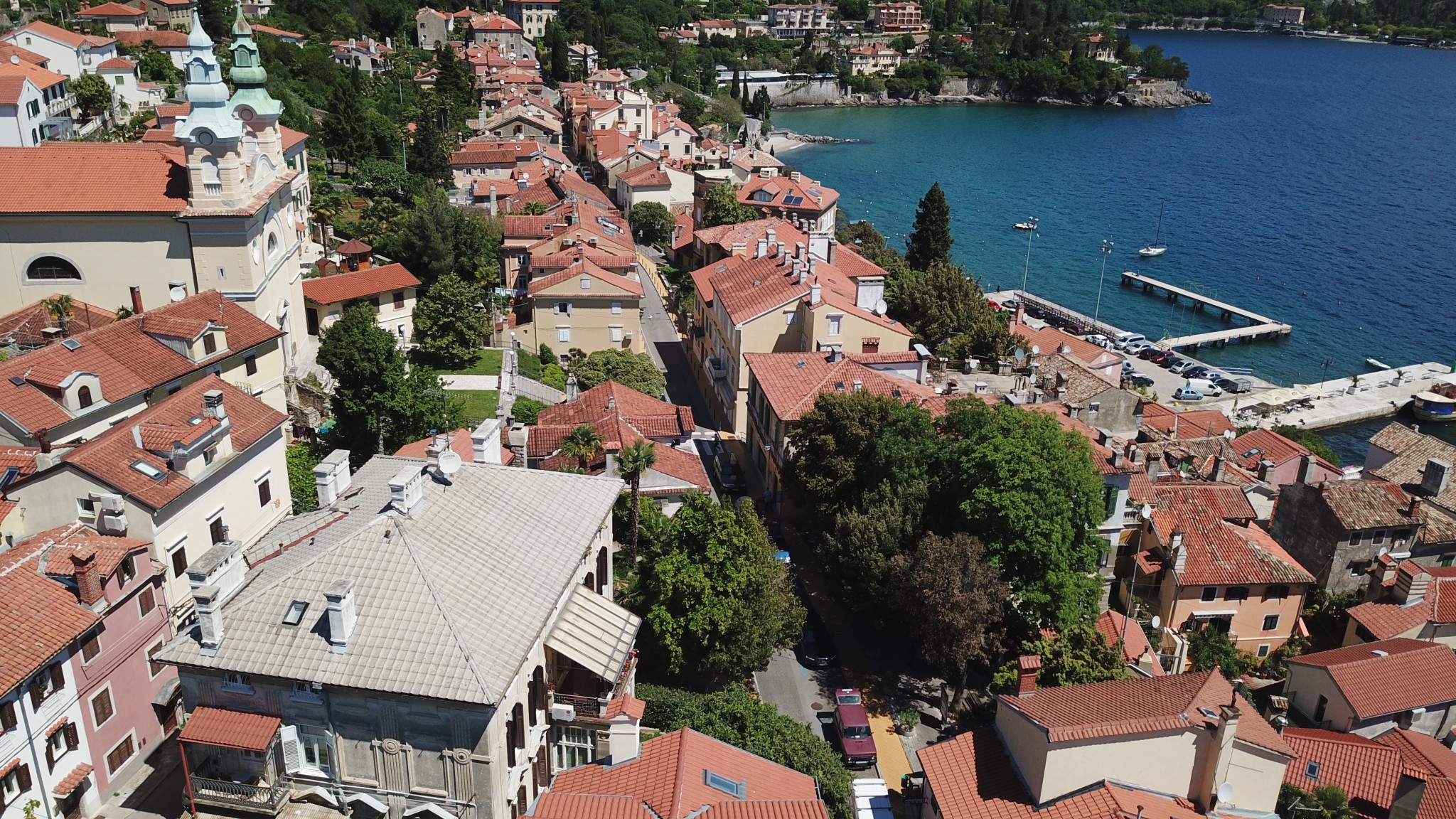
Volosko, photo: Geoarheo
Underwater sculpture and stone bust at the entrance to Volosko – an artistic expression of biodiversity
Volosko is a village with a long and storied history where nature and the local community come together. The dialogue between nature, sea and the people living on the coast served as a framework for the collaboration between two artists invited to participate in the project. Nika Laginja, a young artist from nearby Opatija, is focused on creating an underwater artistic sculpture comprising moss animals, shellfish, sponges and other organisms that were placed on a stone structure to keep the sea clean. This permanent sculpture, which will grow with each year, contributes to restoring the biodiversity of the seabed. The aim of the project isn’t making a change on a global scale, but stimulating individual involvement and taking responsibility for the world we inhabit. Jiří Kovanda, the renowned contemporary Czech artist, whose work mostly deals with the social transformation of Central European countries historically governed by totalitarian regimes, will respond to Nika Laginja’s underwater project with a stone sculpture focusing on the environmental and social context. Jiří Kovanda will place his minimalist installation, which is carved from stone and inspired by local nature and history, at the top of the seaside promenade. It is akin to a bust with an inscription detailing the plant or animal species that was present in the area in a specific year (which is connected to Andrija Mohorovičić, a world-renowned scientist who was born in Volosko), but has since become extinct.
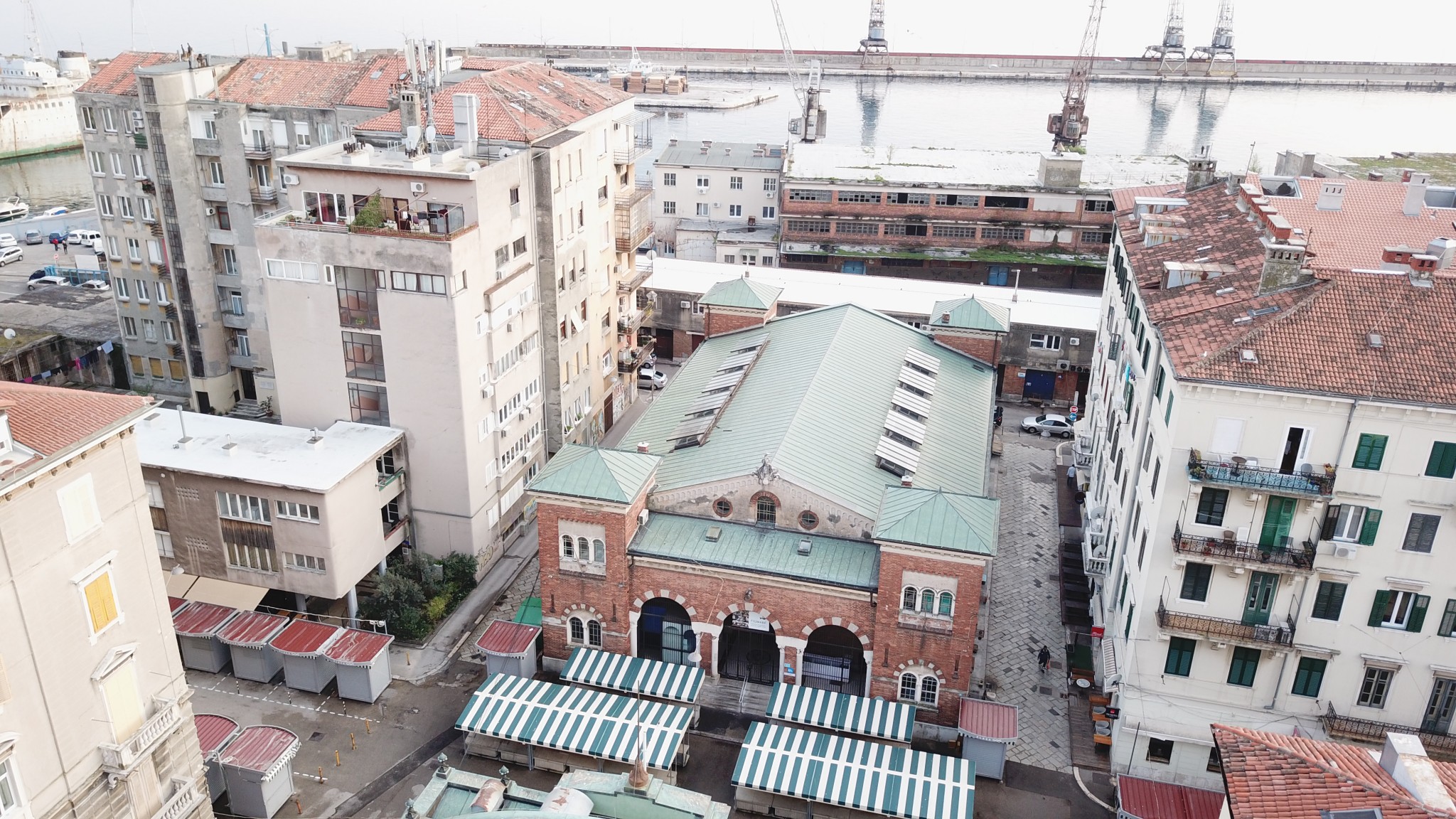
Rijeka’s fish market, photo: Geoarheo
The Rijeka Fish Market overlooking the vendors and customers receives digital image and sound
The impressive building of the Rijeka Fish Market, which was built in 1916, is a symbol of the city, along with the two nearby pavilions at the market, as well as a daily venue where the personal stories of people who, for centuries, have been beholden to the sea entwine.
The Czech visual artist Pavel Mrkus diverts his focus from the foot of the high arch of the Rijeka Fish Market towards the unused interior balconies of the building where he will place his installation, which consists of a projected digital image and a sonic composition, in 4 round openings. This will allow him to tell an abstract story that flows above the heads of the saleswomen and customers like the waves of the nearby sea. You can hear the voices of fishermen during fishing, followed by the voices of women selling fish at the market and yelling out the offer, discussions about the best kind of fish and neighbourly greetings and stories. The visual part of Mrkus’ installation enhances the current appearance of the fish market and enriches the fresh catches and the usual purchase of fresh fish and seafood for anyone casting an eye on the installation. The artist’s rendition of everyday life in Rijeka, which consists of the denizens of Rijeka selling and buying fish, meeting up and talking to each other, provides the experience of observing this area from a new and enriched perspective.
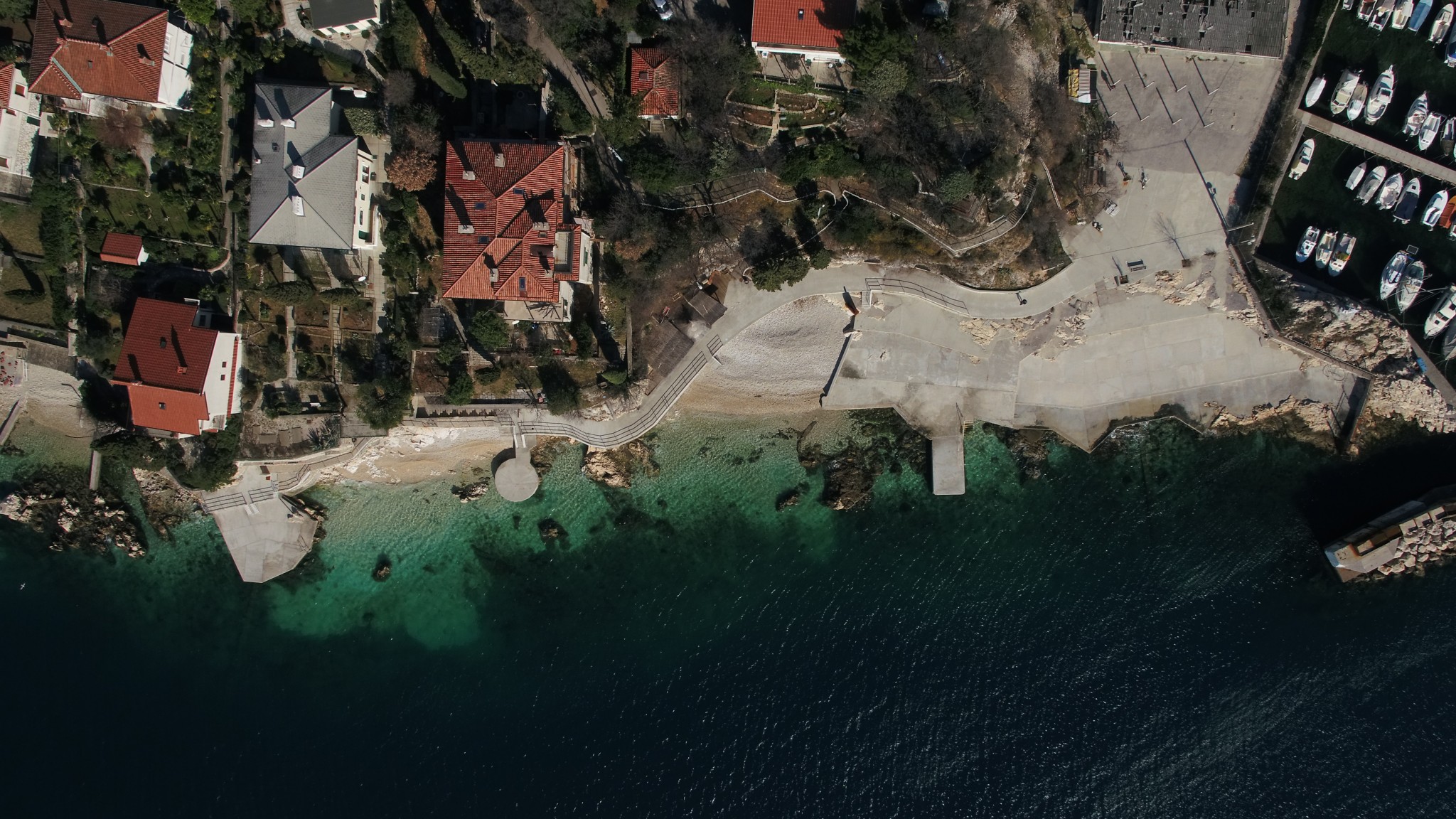
Rijeka – Grčevo, photo: Geoarheo
Balthazar is coming to Pajol
The Balthazartown beach at what is actually Grčevo Beach in the Rijeka neighbourhood of Pećine (a.k.a. Šestica or Pajol) is a collaborative effort by the Lungomare Art and Children’s House flagships of Rijeka 2020 – European Capital of Culture.
The vistas of Rijeka are not the images one would usually associate with a typical holiday destination, seeing how the port and factory complexes intertwined with the architecture of residential areas, holiday facilities and entertainment venues in the late 19th and early 20th centuries during the sudden urban expansion of Rijeka. This resulted in small beaches, mostly used by citizens, springing up in the most unusual places. These include Grčevo Beach, better known as Šestica or Pajol, which is located in Pećine on the southern outskirts of the city in the immediate vicinity of the Viktor Lenac Shipyard.
This location was chosen for the project centring on collaboration in which the Academy of Applied Arts, University of Rijeka (APURI) was invited to participate. As part of the project, APURI will offer a two-semester course entitled Spatial Practices 1 &2 during the academic year 2019/2020, in which students will complete this specific project assignment under the guidance of the experienced artist Professor Igor Eškinja.
The project centres on the protagonist of the popular animated series Professor Balthazar, with Rijeka serving as inspiration for the town where Balthazar’s adventures take place. Just as the protagonist of this cartoon prudently sought to improve the lives of his friends and solve minor and major problems within the community using a magical machine that he invented himself, so the students taking the aforementioned two-semester course will contribute to the development of this area, which is popular among the citizens of Rijeka and its visitors.
His ideas are focused on devising and creating an artwork that will become an integral part of Grčevo Beach (on land), while at the same time enhancing its functionality and making it available to the general public.
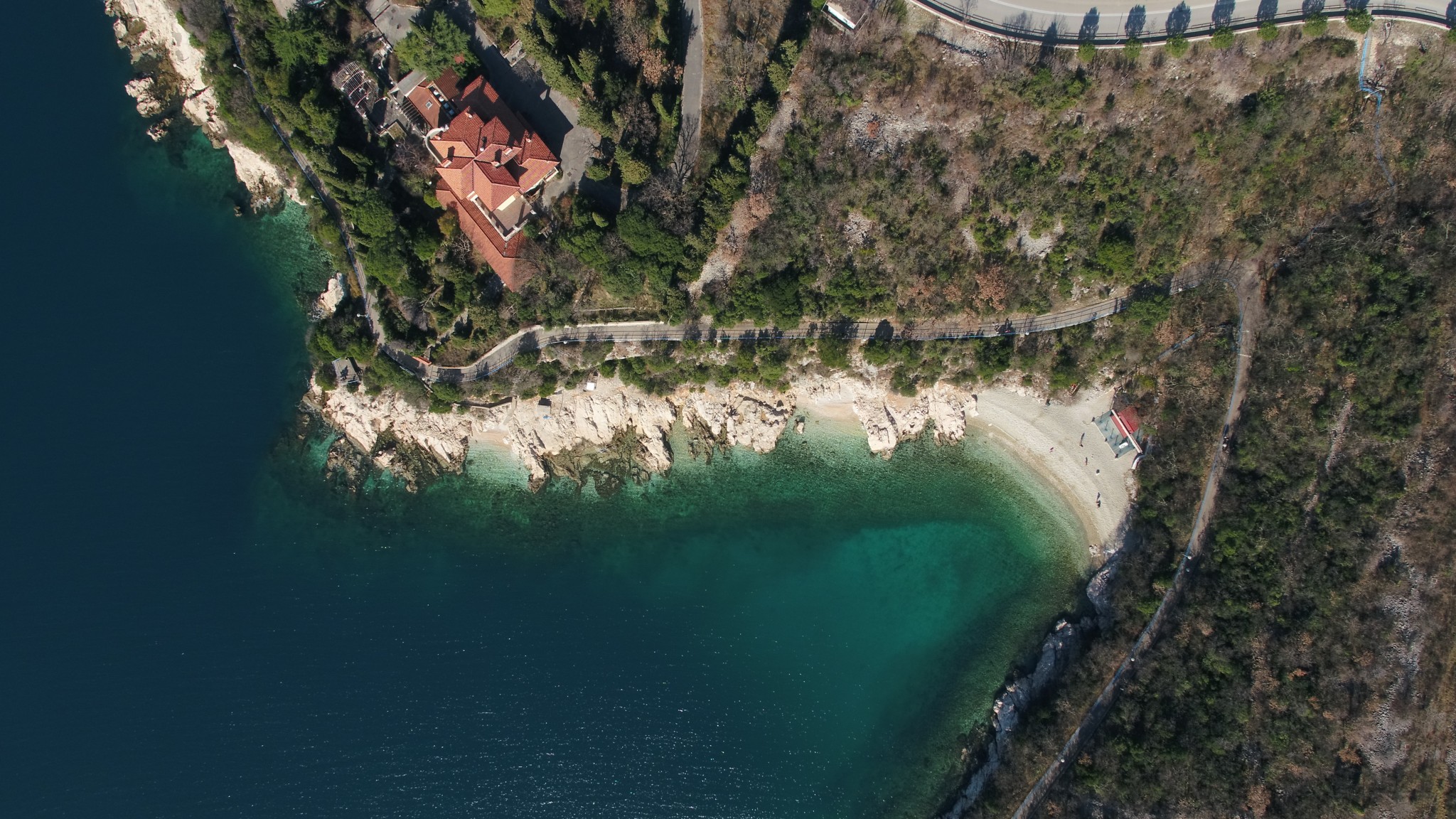
Kostrena, photo: Geoarheo
Svežanj cove in Kostrena receives specially designed beach equipment
The Kostrena Municipality is nestled between the Martinšćica cove, Bakar Bay and gorgeous secluded beaches lining the indented coast and as such is a very popular holiday and recreation destination among people of all ages. The stunning Svežanj beach here will be given an artistic makeover. Since the cove is not flooded with tourists, making it a refuge for locals, workers, students and pensioners, the designers, an art collective named Numen/For Use that includes German, Austrian and Croatian artists, is obliged to take a thorough approach based on detailed analysis and meeting the needs of the beachgoers.
Numen/For Use will design several items of urban beach equipment, such as a bench, a lifeguard tower etc. and install them on the beach. In addition to directly modifying the surroundings of Svežanj Beach, which increases the number of ways in which the area can be used, the project also focuses on the functional role of a communal public space. Kostrena Municipality reserves the copyright for the newly designed urban beach equipment, which can be reproduced and placed at other Kostrena beaches in upcoming years, considering the manner of its utilisation.
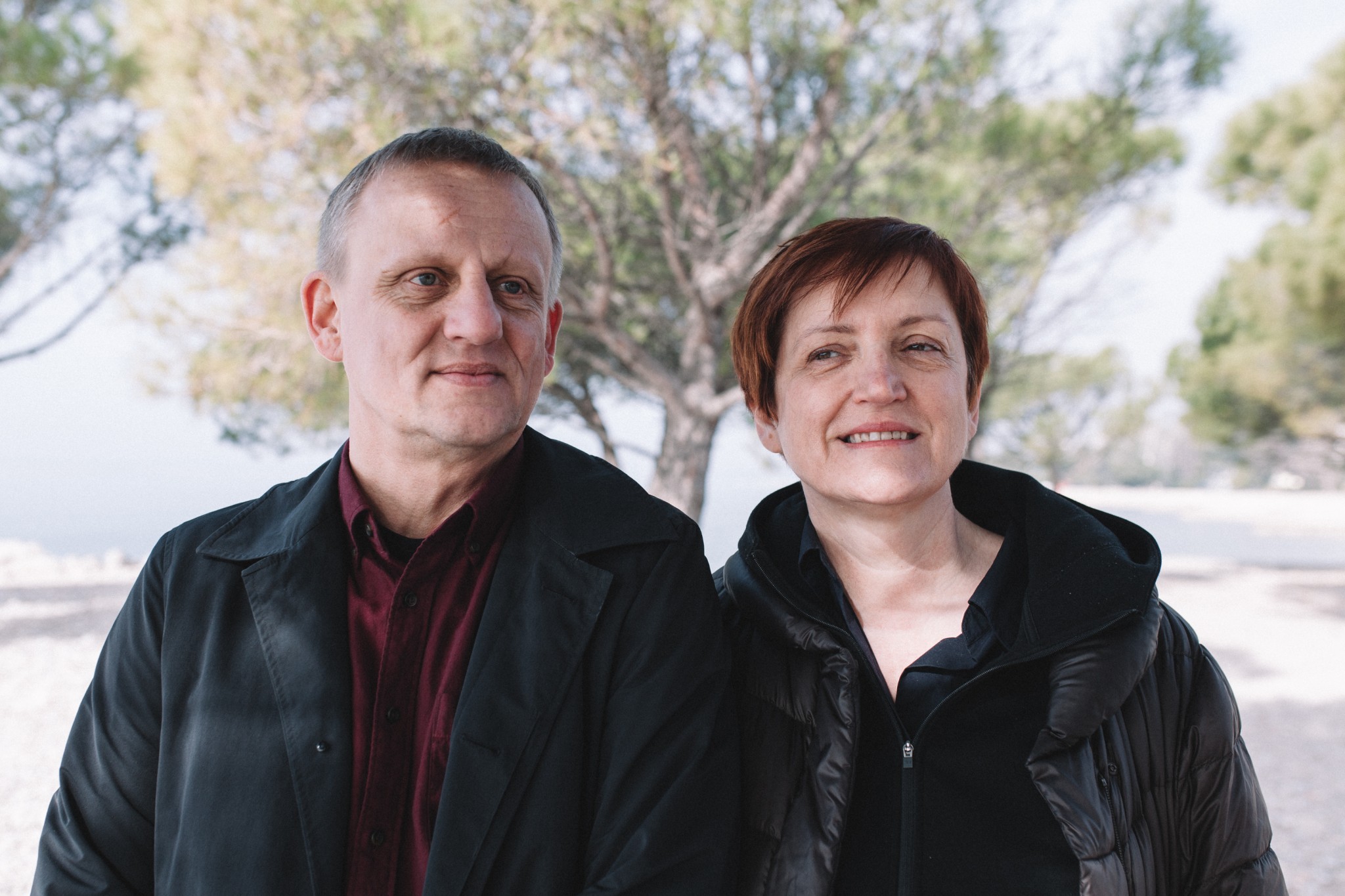
Ilona Németh & Marián Ravasz, photo: Tanja Kanazir
The hospitality of Crikvenica featured in artwork by Slovak artists
The artist Ilona Németh and the architect Marián Ravasz from Slovakia came up with the idea to carry out an art project honouring the history of Crikvenica in the 20th century at the park outside the Miramare hotel. Their three-fold project includes the hospitality of Crikvenica, memories of women that participated in homemade salt production and exchange and paying homage to the existing monument dedicated to Vladimir Nazor.
Historically speaking, this town is associated with providing hospitality to tourists, which has visibly affected the landscape of the town. Moreover, Crikvenica has been associated with hospitality and accepting people in need of medical care or rest and providing hospitality to refugees and immigrants during various periods of the 20th century.
Besides hospitality, the Slovak artists would also like to pay tribute to a certain WWII-related phenomenon in Crikvenica. At the time, women stepped in for men who left to fight in the war by extracting salt from seawater and exchanging it for food and other items in order to survive. Memories of such activities are still passed on from one generation to the next through oral testimonies.
The artwork also pays homage to the existing monument dedicated to the Croatian poet, novelist and politician Vladimir Nazor. The monument, dating back to 1973, was made by Zdenko Kolaci and is an abstract flower-shaped sculpture and an example of the globally popular Yugoslav monumental style that fused historical context with modernist art concepts.
This new artwork, which will be created in a public space, reflects the character of Crikvenica as a town open to strangers, regardless of whether they are coming on holiday or seeking refuge. The artistic sculpture that will be created for the occasion provides a symbol for hospitality in the form of a concrete table as a meeting place where people can communicate and share their thoughts. The table becomes a place for private discussions and meetings, rest, telling local stories to tourists and a memorial for the locals.
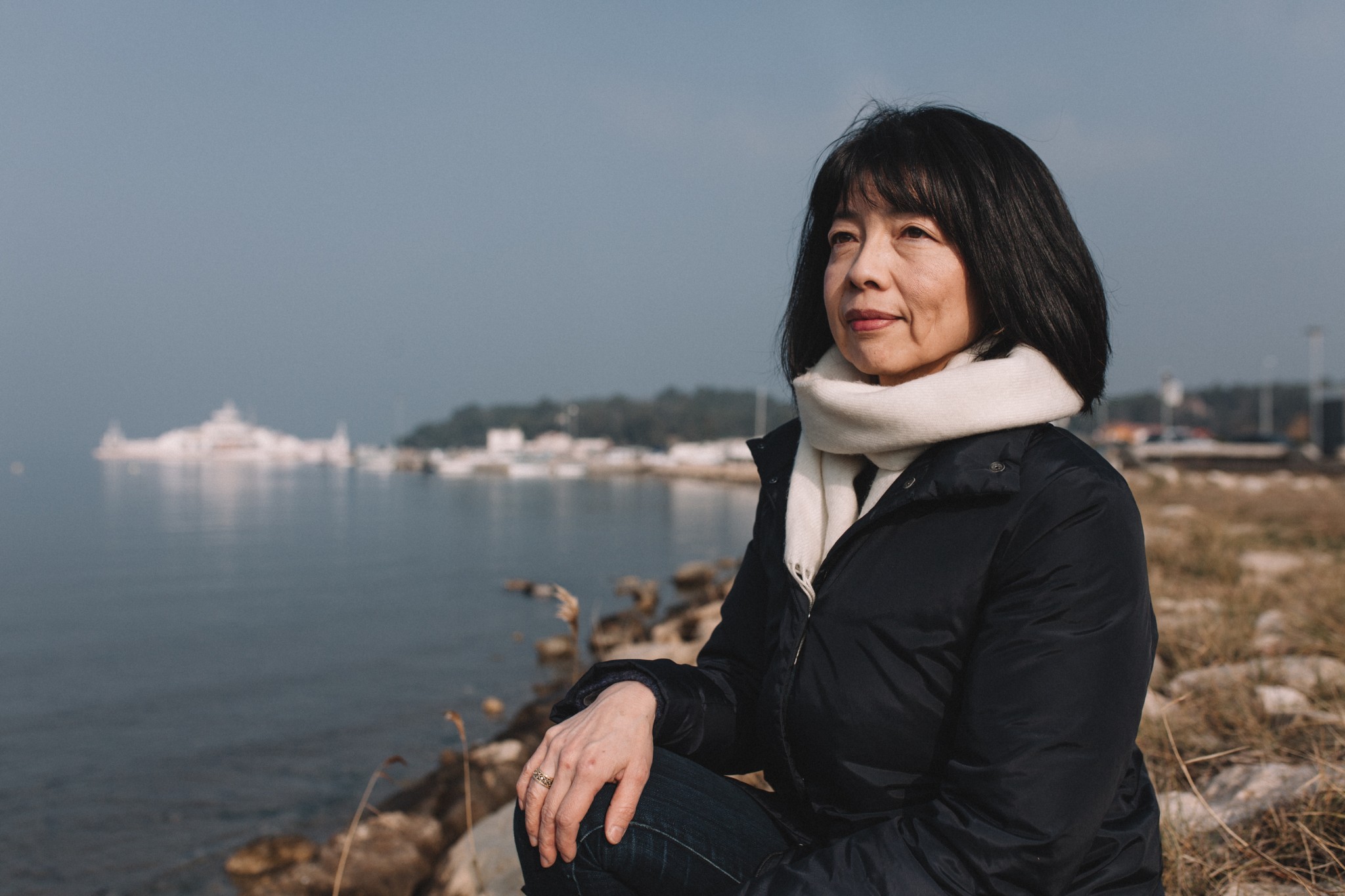
Harumi Yukutake, photo: Tanja Kanazir
A Japanese artist revitalises the ferry port on Rab Island with a sculpture made from stone and sand
Lopar is a settlement that just recently, in 2006, received the status of a municipality. Nature and the tourist industry have a significant effect on the settlement and everyday life there since it is a popular tourist destination, especially among families with children.
The notable Japanese artist Harumi Yukutake decided to create an intervention at Kapić park near the ferry port by drawing inspiration from local materials, particularly stone and sand, which, according to oral tradition, used to be transported to Venice for making glass. This artistic approach will yield a sculpture that will become a permanent fixture at the park. The artist’s work alludes to the specific quality of the local nature and scenery, as well as the social and economic development of the tourism industry in Lopar. It focuses on the creation of an architectural structure that will support the identity of the settlement and its cultural appeal.
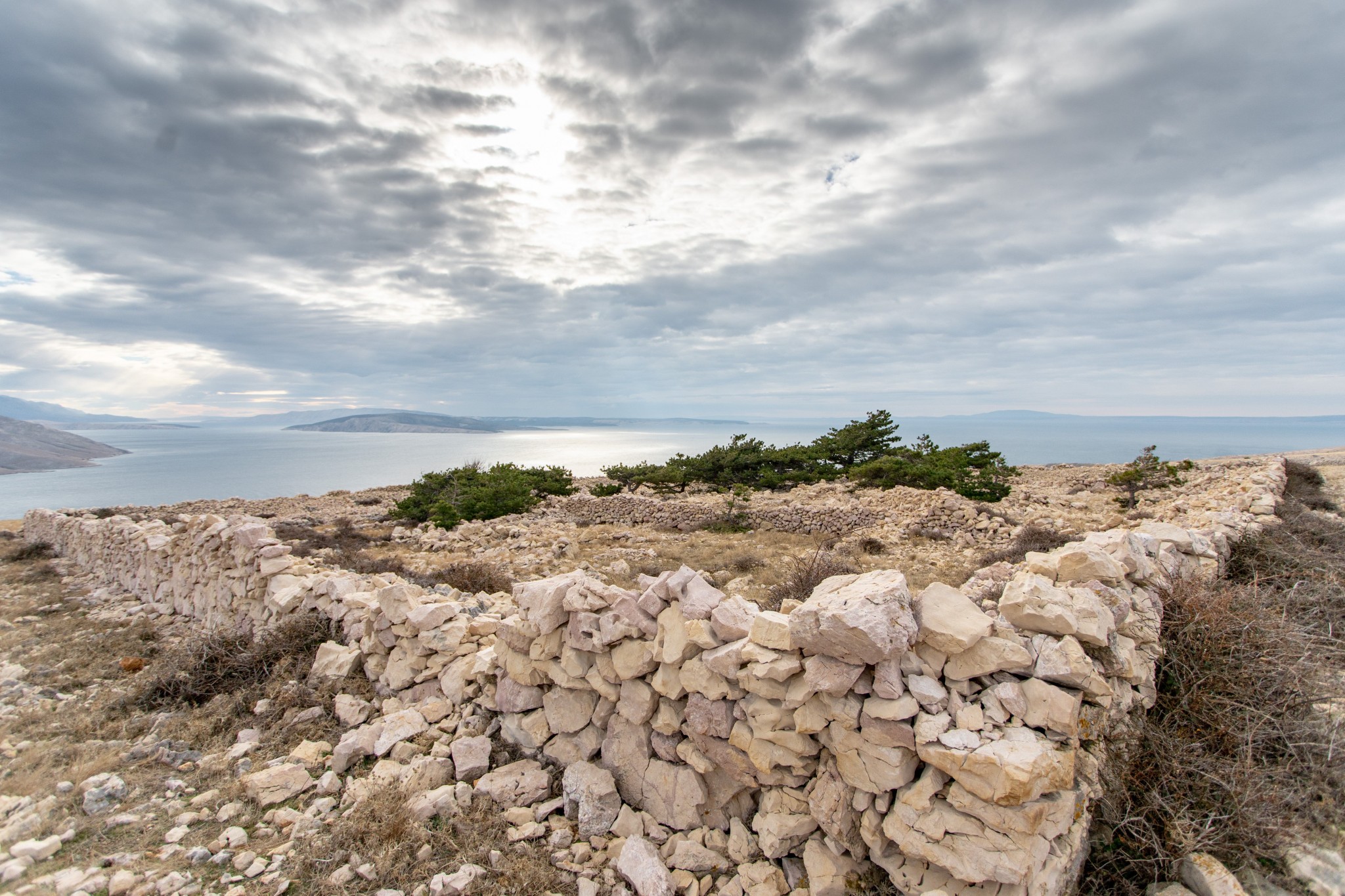
Baška, photo: Kristijan Vučković
Stone “mrgari” (sheepfolds) above Baška as interpreted by Chilean artists
The nature and life on the high and rounded mountain ridges above Baška have been shaped by the wind and sun for centuries. In order to somewhat tame this wild environment, people built a sophisticated system of seemingly endless stone walls and fences that limited the movement of the sheep flocks and protected the grown plants from the harsh weather conditions. Located just above the enchanting Vela Plaža in Baška is Ljubimer, a place that offers a breath-taking view and features these characteristic stone structures called “mrgari”, which are large flower-shaped dry-stone walls that can only be found in the south of Krk Island and the neighbouring Prvić Island, when it comes to Croatia – as well as in only two other countries: Iceland and Wales.
One of the most internationally acclaimed living architects, Smiljan Radić, a Chilean of Croatian descent and his partner Marcela Correa, a Chilean sculptor, have decided to create a one-of-a-kind artwork, which looks like structures from another world and will be installed in this captivating location. The area overlooking Baška is already an attractive and well-known tourist destination due to its hiking trails and it will be further enriched with this installation that puts the “mrgari” at the forefront, while at the same time honouring its value and structure without overshadowing them with the design and materials.

Liam Gillick, photo: Geoarheo
A British artist’s fascination with the fusion of shipbuilding and tourism in Mali Lošinj
The town of Mali Lošinj is a place where the influence of tourism on the towns in Kvarner and their shipbuilding tradition is clearly visible. An operational shipyard is located just a few metres from the town centre. The artwork that is being created there is primarily aimed at the mutual relationship between two seemingly opposite worlds – tourism and industrial production. It deals with the co-existence of the industrial history of shipbuilding, one of the most prominent industries among the inhabitants of the island, and the tradition of tourism, which has been growing for over 150 years.
The internationally acclaimed British artist Liam Gillick draws attention to the top of the “riva” (seaside promenade) in Mali Lošinj near the shipyard. His impressively structured artwork outlines the themes pertaining to the perceived disparity between the industrial and tourism aspects of the town. With his utilisation of high-quality industrial materials, the artist emphasises the development of modern, and especially post-modern art, by enhancing the ambience and the openness of the town towards the history of the local community and its cultural development.
Liam Gillick’s latest artwork, a type of bench in a public space in Mali Lošinj, with universal mathematical formulas etched into them, will be located in the immediate vicinity of the Museum of Apoxyomenos and the anchored ship Logar Nerezinac.
The artworks included in the Lungomare Art flagship will be installed at the aforementioned locations from April to September of 2020 as part of the European Capital of Culture programme.
Another integral part of the Lungomare Art flagship is the project Authorial Boras, a collection of stories also inspired by the small towns and villages across Kvarner, which will be announced on 12 September 2019 at the Rijeka Fish Market as part of the warm-up programme for 2020.










